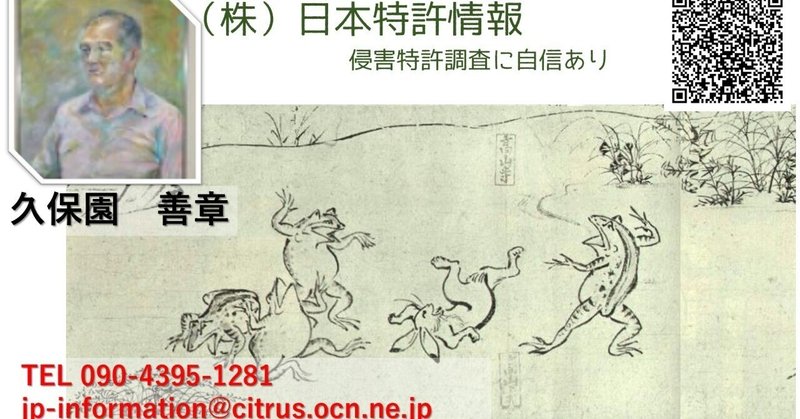
どうする特許庁! 目覚めよ審査官!! そしてまた、お粗末な「審査」(サーチ)による特許付与を、です。
知的財産高等裁判所により、「権利無効」とされたものの70件目です。
https://drive.google.com/file/d/1lGwf_knngi_ox1kEsTIQwMcxO2IDKOPc/view?usp=drive_link
特許権者である原告の原田工業株式会社は、自分が保有する特許第5,237,617号(アンテナ装置)について、その特許の「有効性」を検証したか不明です。
「有効性」とは、自社の特許についての、例えば「無効資料調査」等を行うことで、たとえ利害関係者などの第三者からの「無効審判」を起こされても、自社の特許は盤石であると確信することです。
それにも拘らず、原田工業株式会社は、特許庁より与えられた特許を有効と信じて、被告である株式会社ヨコオを特許侵害している、と提訴しました。
しかしながら、知的財産高等裁判所は「請求項1に係る特許は,サポート要件を充足せず,特許無効審判により無効にされるべきものと認められる。したがって,控訴人は被控訴人に対して特許権を行使することができない。」とし、結局、控訴人は敗訴しました。
一方、特許庁の審査官は、「この出願は、特許請求の範囲の記載が特許法第36条第6項第1号に規定する要件を満たしていない。」との拒絶理由通知書を発していました。
即ち、審査官は知的財産高等裁判所と同様に、「サポート要件」を満たしていない、と判断しています。
その後、出願人より「手続補正書」が出されて、結局、審査官は「登録査定」をし、出願人は特許権を得ました。
しかし、特許権者は知的財産高等裁判所において、上記のように敗訴しました。
本件の根本原因は、知的財産高等裁判所での「請求項1に係る特許は,サポート要件(特許法36条6項1号)を充足せず,特許無効審判により無効にされるべきものと認められる。」との判断を、審査官が堅持しなかったことにあると考えます。
特許庁の審査官が、何故、サポート要件(特許法36条6項1号)を強く主張して、「拒絶査定」を下さなかったのか不思議です。
本来なら、原田工業株式会社の出願に対して、特許庁は特許を与えるべきでなかったと考えます。
ちなみに、特許権者は最高裁判所へ上告しましたが、敗訴が確定しています。
「行政」(特許庁)としては、「司法」(裁判所)により誤りを指摘されたことを謙虚に反省し、その誤りを正すことを心掛けるべきです。
なお、ここで、本件特許公開の「出願情報」のうち「FI」と「Fターム」を、本エクセル資料の2シート目以降に挙げておきました。
( Google Translation )
What will the patent office do! Wake up Judge! !
And also, granting patents through poor "examination" (search).
This is the 70th case where the Intellectual Property High Court has declared "invalidity".
It is unclear whether the patent holder, the plaintiff, Harada Kogyo Co., Ltd., has verified the "validity" of its patent No. 5,237,617 (antenna device).
"Validity" means that even if a third party such as an interested party raises an "invalidation trial" by conducting, for example, an "invalid material investigation" for the company's patent, the company's patent is It is to be convinced that it is rock solid.
Despite this, Harada Industries believed that the patent granted by the Patent Office was valid, and sued the defendant, Yokowo Co., Ltd., for patent infringement.
However, the Intellectual Property High Court said, ``It is recognized that the patent pertaining to claim 1 does not satisfy the support requirements and should be invalidated by the patent invalidation trial. I cannot exercise my rights."
In the end, the appellant lost the case.
On the other hand, the examiner of the Patent Office issued a notice of reasons for refusal stating that "the description of the scope of claims of this application does not meet the requirements prescribed in Article 36(6)(i) of the Patent Act." was In other words, the examiner has determined that the "support requirement" is not met, as with the Intellectual Property High Court.
After that, the applicant issued a "Written Amendment", and in the end, the examiner made a "decision of registration" and the applicant obtained the patent right.
However, the patentee lost the case in the Intellectual Property High Court as described above.
The root cause of this case is that the Intellectual Property High Court said, "The patent pertaining to Claim 1 does not satisfy the support requirements (Article 36, Paragraph 6, Item 1 of the Patent Act) and should be invalidated by a patent invalidation trial.
I believe that the reason is that the examiner did not firmly adhere to the determination that "the application is accepted."
I wonder why the patent office examiner insisted strongly on the support requirement (Article 36, Paragraph 6, Item 1 of the Patent Law) and did not issue a "decision of refusal".
Originally, I think that the Patent Office should not have granted a patent to Harada Industries Co., Ltd.'s application.
By the way, the patentee filed an appeal to the Supreme Court, but the loss has been finalized.
As the “administration” (the Patent Office), we should humbly reflect on the fact that the “judicial” (the court) pointed out the error, and should try to correct the error.
In addition, here, "FI" and "F term" in the "application information" of this patent publication are listed after the second sheet of this Excel document.
(Google 翻译)
专利局会做什么! 法官醒醒吧! !
而且,通过糟糕的“审查”(搜索)来授予专利。
这是知识产权高等法院宣布“无效”的第70起案件。
目前尚不清楚专利权人原告原田工业株式会社是否验证了其第5,237,617号专利(天线装置)的“有效性”。
“有效”是指即使利害关系人等第三方通过对公司的专利进行“无效材料调查”等方式提出“无效审判”,该公司的专利仍应被确信是坚如磐石。
尽管如此,原田工业公司仍认为专利局授予的专利有效,并起诉被告横工株式会社侵犯专利权。
然而,知识产权高等法院表示:“公认权利要求1的专利不满足支持要求,应通过专利无效审判宣告无效。我无法行使我的权利。”
最终,上诉人输掉了官司。
另一方面,专利局审查员发出驳回理由通知书称“本申请的权利要求范围的描述不符合专利法第三十六条第(6)款第(i)项规定的要求” ”是 换句话说,与知识产权高等法院一样,审查员确定不满足“支持要求”。
之后,申请人发出“书面修改意见”,最终审查员作出“注册决定”,申请人获得了专利权。
但如上所述,专利权人在知识产权高等法院败诉。
本案的根本原因在于,知识产权高等法院认为:“权利要求1的专利不符合支持要件(专利法第36条第6项第1项),应以专利无效宣告宣告无效”。
笔者认为,原因是审查员没有坚定地坚持“受理申请”的认定。
我不知道专利局审查员为何坚决坚持支持要求(专利法第三十六条第六款第一项),而不作出“驳回决定”。
本来我认为专利局不应该对原田工业株式会社的申请授予专利。
顺便说一句,专利权人向最高法院提起了上诉,但损失已经确定。
作为“行政部门”(专利局),我们应该虚心反思“司法部门”(法院)指出的错误,并努力纠正错误。
另外,这里,该专利公开的“申请信息”中的“FI”和“F项”列在该Excel文档的第二页之后。
この記事が気に入ったらサポートをしてみませんか?
